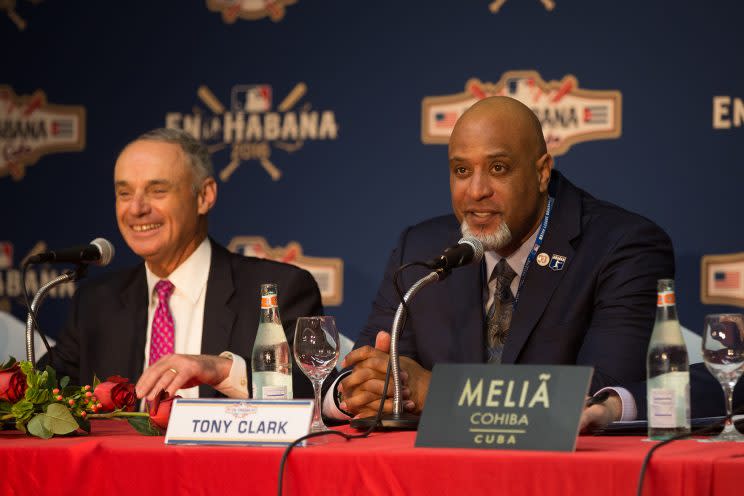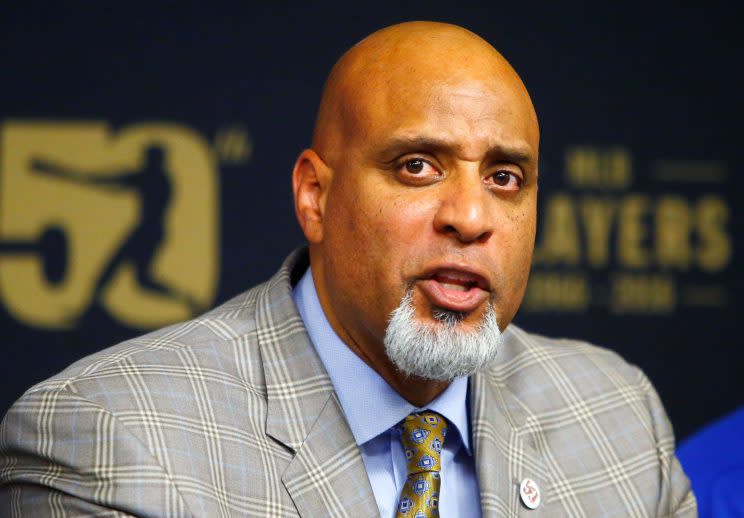MLB and players union reach agreement on new CBA before deadline
It may have come down to some dramatic, final-hour negotiations, but there will be baseball in 2017. The owners and players union came to an agreement on a new collective-bargaining agreement (CBA) Wednesday night, avoiding a possible work stoppage hours before the 12 a.m. ET deadline, according to multiple sources. There will be labor peace in baseball for at least the next five years.
Yahoo Sports’ Jeff Passan was in the thick of the news breaking:
Sources: MLB and the MLBPA have agreed on a five-year deal.
— Jeff Passan (@JeffPassan) December 1, 2016
MLB's new collective-bargaining agreement will take them past a quarter century of labor peace. Incredible considering the league's history.
— Jeff Passan (@JeffPassan) December 1, 2016
Among the decisions in the new agreement, according to various reports:
• There won’t be an international draft, as owners wanted. The union won that issue, but did concede a yearly cap on international spending.
• An overhaul of the qualifying-offer system will get rid of first-round draft-pick compensation. Teams will still get picks when a player tagged with a qualifying offer departs for another team, but it won’t be a first-rounder. That’s another win for the players union.
• The luxury-tax threshold will stay the same initially, but expand over the five years of the deal.
• Despite talk of rosters to expanding to 26, they’ll stay at 25.
A new deal was no certainty considering the state of negotiations the week before the deadline. With the deadline quickly approaching, both sides did some saber-rattling in the media, trying to convince the other side that they wouldn’t back down on big issues. The first, and most significant, report suggested the owners would consider a lockout if the players failed to meet their demands. Had that happened, it would have been the first time in 21 years baseball experienced a work stoppage.
The union didn’t go for that threat, and things seemed bleak for a roughly 24 hours. But with the deadline rapidly approaching, coverage of the negotiations suddenly became more optimistic. The owners were willing to back off some of the more contentious issues in the CBA, and more stories emerged where both sides came together for all-night negotiation sessions. As Thursday’s deadline approached, it became clear neither side wanted to ruin a good thing.
Still, while things seemed promising in the hours leading to the deadline, there were still significant issues both sides needed to discuss. Early on, it appeared an international draft was the most controversial issue on the table. The owners argued in favor of draft, mainly as a way to save money on signing international free agents. As this would potentially limit player salaries, the union strongly opposed the idea. The players union even went so far as to send Latin American players to negotiations to argue against the measure. The owners reportedly dropped the issue in the days leading up to the deadline.

Though the international draft was off the table, owners still wanted some type of cap limit on international signings. Going forward, international signings will be limited to between $5 million and $6 million per team each year, according to Jon Heyman.
With that issue solved, the luxury tax and draft-pick compensation became the other major issues facing both sides in the final days of negotiations.
On the luxury tax issue, owners were hoping to keep the figure at $189 million in the first year of the new agreement, according to USA Today. That’s exactly where the figure has stood in each of the past three seasons. The luxury tax functions as somewhat of a salary cap for teams. Yes, you can have a payroll that exceeds $189 million, but the league will tax you if you go over that limit. Given the rising cost of player contracts, the union wanted that figure to rise. If the luxury tax number is higher, teams should be willing to spend more money on players. That’s the thinking, at least.
And that’s precisely what’s going to happen. Both sides agreed to increase the luxury tax incrementally over the next five years, according to Rosenthal.
Source: Luxury-tax thresholds could rise in something close to this progression over new five-year CBA: $195M, $197M, $206M, $209M, $210M.
— Ken Rosenthal (@Ken_Rosenthal) December 1, 2016
There will, however, be steeper penalties for teams that do exceed the new luxury tax limit, according to Joel Sherman, and teams who exceed the most would pay higher tax rates.
The players were also in favor of drastically overhauling the qualifying offer system. Under the current system, players who hit free agency after spending an entire year with a club are subject to the offer. They can either accept a one-year, $17.2 million deal to return to their team, or decline that offer and hit free agency. If the player declines the qualifying offer, their team receives a draft pick when that player signs with another club.
In the unions’ eyes, the current system has limited some free agents earning potential in recent years. Teams are hesitant to give out deals to some players who decline qualifying offers because they do not want to give up draft picks. Players who declined qualifying offers expecting a robust market have been reduced to taking one-year, show-me type deals in order to rebuild their value the following season.

While draft pick compensation was a significant issue, both sides seemed willing to rework the current system. Hours before the deadline, Ken Rosenthal outlined a number of changes both sides were considering under the new CBA. In the end, both sides agreed that some form of draft pick compensation will still exist, but won’t include first-rounders. According to Jayson Stark, the new agreement hinges on whether a team is over its luxury-tax threshold:
Turns out draft-pick compensation won't disappear. Teams over threshold lose a 2nd- & 5th-round pick. Under threshold: lose 3rd-round pick.
— Jayson Stark (@jaysonst) December 1, 2016
One issue that earned a lot of discussion but won’t change is roster size. Many insiders figured the new CBA would allow rosters to expand from 25 to 26, but ultimately, it wasn’t something players insisted on, according to Heyman. Likewise, extended September rosters are here to stay for another five years.
With the agreement, the owners and players union will continue to experience labor peace in the immediate future. Now that both sides have finally agreed to terms on a new CBA, there’s also a chance the free-agent market will pick up. Some teams have been hesitant to make moves before this issue was resolved. The winter meetings, which begin Sunday, should be much livelier now that both sides will be active participants.
Coming to an agreement on a new CBA was the first major hurdle of the 2016 Major League Baseball offseason. With that cleared, the fun — and money-spending — can finally begin.
More MLB coverage from Yahoo Sports:
– – – – – – –
Chris Cwik is a writer for Big League Stew on Yahoo Sports. Have a tip? Email him at christophercwik@yahoo.com or follow him on Twitter! Follow @Chris_Cwik

 Yahoo Sports
Yahoo Sports 
